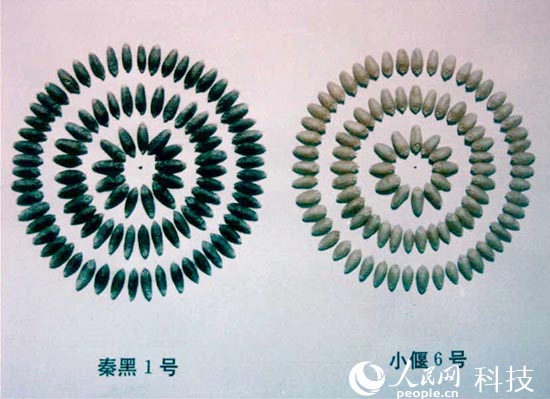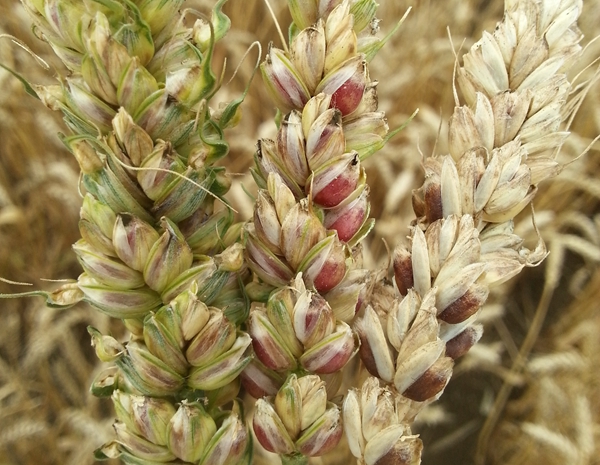The anthocyanin content of colored wheat and colored potato is close to that of blueberry.

People's Daily, Beijing, February 8 (Reporter Jiang Jianke)-to buy flour and steamed bread, the whiter the better. In fact, colored wheat is more nutritious. A few days ago, the reporter saw at the School of Agriculture of Northwest University of Agriculture and Forestry that colorful wheat and potatoes, as well as processed natural-colored bread, noodles, cakes and other foods were dizzying. This is a new achievement made by the research team led by Associate Professor he Yizhe and Professor Chen Qin of Northwest University of Agriculture and Forestry.
In May 1993, Associate Professor he Yizhe collected a wheat sample (2 ears) with extra long awn in the depths of Qinling Mountains. The grain was purple and slender, similar to black rice. After he cut the grain of this specimen, the flour was brown. He Yizhe collected the sample and used it as a special germplasm resource for systematic breeding.
In 1997, he Yizhe bred a strain "Qinhei No. 1" with yield potential of about 300 jin per mu. Tested by the school quality testing center, the contents of micronutrient elements iron and zinc are 19.2 and 4.1 times higher than those of common wheat, respectively, and the contents of nutrients such as manganese, copper, selenium, magnesium, potassium and phosphorus are also higher than those of common wheat. the content of sodium is only 5% of that of ordinary wheat. The total amount of 18 kinds of amino acids is 35.1% more than that of common wheat, in which the content of glutamic acid is 8 times that of common wheat, and the content of essential amino acids such as lysine, methionine, isoleucine and tryptophan is higher than that of common wheat; crude fat is 44.2% lower than that of common wheat. Through the field debugging and scale-up cultivation experiment for three consecutive years, the yield level was finally increased from 300 jin to 500-600 jin, so that the excellent germplasm resources could be developed and utilized. "Qinhei No. 1" is also known as "Xuemai". Its breeding and cultivation techniques were authorized by the national invention patent in 2009, and the trademark was registered in the Trademark Office of the State Administration for Industry and Commerce. Thus it has become the first high nutrition and special wheat germplasm with independent intellectual property rights in China.
On this basis, he Yizhe successively selected a series of color grain wheat, such as Qinhei 2, Qinhei 3, Qinhei 4, Qinhei 5, Xiaoyan Wumai, Zhiluo Wumai and so on.
On this basis, he Yizhe put forward the concept of "nutritional function breeding", which is the third important development stage and direction of crop breeding after "yield breeding" and "quality breeding". Thus a relatively complete theoretical system of "crop nutritional function breeding" is formed. He Yizhe defined "crop nutritional function breeding": to improve the content of mineral nutrients, vitamins and other nutrients in crops that are beneficial to the human body as the breeding goal, and to select parents with excellent target characters. Through traditional breeding techniques, modern breeding techniques or the combination of the two, to cultivate "new varieties of nutritious functional crops" with higher nutrient content of target characters.
After years of efforts, Professor Chen Qin and his team, who returned from studying abroad, have cultivated many new "rose series" colored potato varieties with independent intellectual property rights: red Rose 1, 2, 3; Purple Rose 1, 2, 3; Black Rose 1, 2, 3, 5, 6; Lingshu 1, 2 (yellow, white).
According to reports, these new varieties have achieved a perfect combination of high yield and high nutrition. Its antioxidant substances are 5-10 times higher than those of ordinary varieties, the content of anthocyanin reaches or approaches the level of blueberry, has unique nutritional value, and its yield is 30% higher than that of ordinary varieties.
Color potato is a new variety type which integrates nutrition, health care and natural pigment. It not only contains carbohydrates, starch, protein and other nutrients of common potato, but also contains polyphenolic antioxidant substances such as vitamin C, pure natural anthocyanin and chlorogenic acid, which can be used as food, economic and medicinal crops.
Chen Qin said that because the market price of colored potatoes is higher than that of ordinary potato varieties, and the planting conditions and cultivation techniques are no different from ordinary potatoes, the development of color potato industry in poor areas can increase agricultural production and farmers' income without increasing production costs. At the same time, colored potato can better meet people's demand for health food, and it can be preserved for a long time after being processed into powder, so it has a huge market and development potential.
- Prev

Walking into the Color Wheat cultivation Base of Zhongpu Resource Garden
Walking into the Color Wheat cultivation Base of Zhongpu Resource Garden
- Next

Planting and processing of colored wheat, colored peanut, colored corn and colored beans in Nanyang, Henan Province
Planting and processing of colored wheat, colored peanut, colored corn and colored beans in Nanyang, Henan Province
Related
- A course of planting techniques and methods on how to grow carrots
- How to plant the latest tulips?
- Is it better to pick tea in the morning or in the afternoon? When is the best time for tea to be picked? what is the third or fifth tea?
- Launch Yuanxiao Happy combination Haocha + Tea Yuan healthy Taste
- Penghu Tourism "Fireworks 20 Parade with You"
- 2022 West Lake Happiness holds "Digital Revitalization Voucher" and draws iphone13 and laptop.
- Banqiao Fuzhou social houses are designed to change start-up combined with police elimination to create a safe and livable environment
- The convenient measure of "mechanical weeding" in Xinbei has been abused and the Agriculture Bureau has imposed heavy penalties on the illegal land consolidation.
- Changgeng University Joins Hands with Four Memory Factories to Rescue Memory Talent Shortage
- The list of Taiwan's top 100 MVP managers is listed by the Director-General of the Farmers' Association of Sanxia District.

